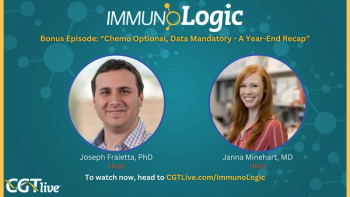
More Data Supports Approval as Lifileucel Review for Melanoma Pushed Back
The new PDUFA date of lifileucel is set for Februrary 24, 2024.
This content originally appeared on our sister site,
The FDA has extended its priority review of Iovance Biotherapeutics’ biologics license application (BLA) for the tumor infiltrating lymphocyte (TIL) therapy
“While the resource constraints at FDA have extended our PDUFA date, Iovance and FDA remain engaged to complete the review process as quickly as possible. We appreciate FDA management’s efforts to expedite the remaining review so that we can bring lifileucel to critically ill patients with no other FDA approved options after current standard of care,” Frederick Vogt, PhD, JD, interim president and chief executive officer, Iovance, said in a statement.1 “We are confident in the potential for lifileucel to redefine the treatment paradigm for these patients. With the strength of our clinical data, manufacturing capabilities, and commercial readiness efforts, Iovance is well positioned to rapidly serve the US melanoma community immediately following an approval.”
The FDA told Iovance that the delay is due to insufficient resources to review a recent response to an information request for the ongoing BLA review prior to the planned late-cycle review meeting scheduled for September 11, 2023. The original target PDUFA date was set for November 25, 2023.
A few weeks after the announcement, Iovance presented more
READ MORE:
At a median follow-up of 35.7 months, patients who received the tumor-infiltrating lymphocyte therapy (n = 12) experienced an objective response rate (ORR) of 50% (95% CI, 21.1%-78.9%), including 1 patient who achieved a complete response. Four patients had stable disease and 2 had disease progression (PD). Notably, at the July 15, 2022, data cutoff, 4 of the 6 responders had durable and ongoing responses.2
“Advanced mucosal melanoma is rare and difficult to treat, with poor outcomes after anti–PD-1 therapy,” Evidio Domingo Musibay, MD, an assistant professor of medicine in the Division of Hematology, Oncology, and Transplantation at the University of Minnesota Medical School in Minneapolis, said during his presentation.2 “ORRs tend to be low at 19% to maybe 23% [with a] median overall survival [OS] of 11.3 to 16.0 months. [In a previous study], lifileucel autologous tumor-infiltrating lymphocyte therapy demonstrated an ORR of 31.4% in heavily pretreated patients [n = 153] with advanced melanoma.”
C-144-01 was a multicenter trial that enrolled patients with unresectable or metastatic stage IIIc or IV melanoma who progressed on or after anti–PD-1 therapy. Patients needed to have an ECOG performance status of 1 or less, an estimated life expectancy of at least 3 months, and adequate organ function in order to be eligible for the study. Patients who received an organ allograft or prior cell transfer therapy, had symptomatic and/or untreated brain metastases, or had BRAF-mutated disease and did not receive prior therapy with a BRAF inhibitor, were excluded.
Following tumor tissue procurement and GMP manufacturing which took approximately 22 days, patients received a nonmyeloablative lymphodepleting regimen with cyclophosphamide from day -7 to day -6 followed by fludarabine from day -5 to day -1. Patients received lifileucel infusion on day 0, followed by IL-2 on day 0 to day 4. After the end of treatment, the efficacy follow-up lasted until patients experienced PD or started a new therapy.
The primary end point was ORR. Secondary end points included duration of response (DOR), disease control rate, progression-free survival, overall survival, and incidence of adverse effects (AEs).
At baseline, the median age was 61.5 years (range, 37-79) and the median number of prior lines of therapy received was 2 (range, 1-6). Most patients had disease that was primary refractory to anti–PD1/L1 treatment (83.3%), 41.7% had liver or brain metastasis, and 41.7% had lactate dehydrogenase levels above the upper limit of normal. The median number of target and nontarget lesions was 6 (range, 3-13) and the median target lesion sum of diameters was 118.9 mm (range, 20.7-260.9).2
The median number of IL-2 doses was 5.5 (range, 3-6). Additionally, the median number of tumor-infiltrating lymphocytes infused was 26.1 x 109 cells (range, 3.3 x 109 to 72 x 109).
Additional findings from the study demonstrated that the median DOR was not yet reached (NR; 95% CI, 12.5-NR). All patients experienced a DOR lasting at least 6 months, 83.3% had a DOR of 12 months or more, and 66.7% had a DOR spanning at least 24 months.2
Data from a sub-analysis revealed that the mean tumor mutational burden of patients with mucosal melanoma was low compared with those with cutaneous disease, at 2.145 mut/Mb vs 10.47 mut/Mb, respectively. Moreover, tumor-infiltrating lymphocyte persistence was similar in both groups of patients through 1 year.2
In terms of safety, grade 3/4 nonhematologic treatment-emergent AEs (TEAEs) consisted of febrile neutropenia (58.3%), hypotension (33.3%), and hypoxia (16.7%). The most common any-grade TEAEs included chills (75.0%), febrile neutropenia (58.3%), diarrhea (58.3%), and pyrexia (41.7%). Regarding grade 3/4 hematologic laboratory abnormalities, all patients experienced neutropenia, leukopenia, lymphopenia, and thrombocytopenia, and 8 patients experienced anemia.
“The antitumor responses observed in mucosal melanoma were consistent with responses observed in the overall population,” Domingo-Musibay said.2 “TRAEs were consistent with the known safety profiles of nonmyeloablative lymphodepletion and high-dose IL-2. These results further support the potential benefit of lifileucel as a one-time treatment that is differentiated from other immunotherapies.”
REFERENCES
1. U.S. Food and Drug Administration updates Prescription Drug User Fee Act (PDUFA) action date for lifileucel for the treatment of advanced melanoma. Iovance Biotherapeutics. September 14, 2023. Accessed September 15, 2023. https://ir.iovance.com/news-releases/news-release-details/us-food-and-drug-administration-updates-prescription-drug-user
2. Grigoleit GU, Kluger H, Thomas S, et al. Lifileucel tumor-infiltrating lymphocyte (TIL) cell therapy in patients (pts) with advanced mucosal melanoma after progression on immune checkpoint inhibitors (ICI): results from the phase II C-144-01 study. Ann Oncol. 2023;34(suppl 2):S654. doi:10.1016/j.annonc.2023.09.2220
Newsletter
Stay at the forefront of cutting-edge science with CGT—your direct line to expert insights, breakthrough data, and real-time coverage of the latest advancements in cell and gene therapy.





































